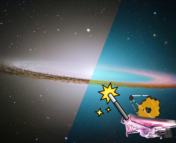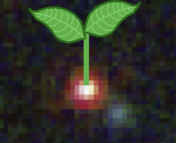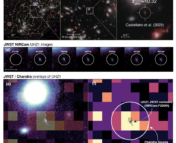Title: Feeding Hidden Monsters: a Super-Eddington accreting Black Hole ~1.5 Gyr after the Big Bang
Authors: Hyewon Suh, Julia Scharwächter, Emanuele Paolo Farina, Federica Loiacono, Giorgio Lanzuisi, Günther Hasinger, Stefano Marchesi, Mar Mezcua, Roberto Decarli, Brian C. Lemaux, Marta Volonteri, Francesca Civano, Sukyoung K. Yi, San Han, Mark Rawlings, Denise Hung
First Author’s Institution: Gemini Observatory/NSF’s NOIRLab, Hilo, Hawaii, USA
Status: Available on ArXiv
The James Webb Space Telescope (JWST) has recently made headlines for discovering massive black holes in the early universe. There have been several instances of black holes with masses over a million times more than our sun discovered just a few million years (at cosmological redshifts above 6) after the Big Bang. JWST also saw a population of “little-red-dots” which are a group of faint, compact (with a small radius), and red (due to dust) galaxies with an AGN (active galactic nuclei). Such red compact AGNs are surprisingly found in abundance at cosmological redshift (hereafter referred to as redshift) between 3-4, a few billion years after the birth of the universe.
These discoveries are puzzling astronomers and it has raised more questions about the formation and growth of early supermassive black holes (SMBHs). There are competing theories that explain the origins of SMBHs that form from a light or heavy “seed” black hole (BH). The seed BHs grow by accreting matter that is capped at a rate called the Eddington limit. The Eddington limit is the maximum luminosity of the AGN from balancing the radiation pressure that acts outward and the gravitational attraction force of the black hole acting inwards.
In today’s paper, the authors talk about the discovery of a low-mass SMBH (millions times more massive than the Sun) LID-568, found at a redshift of 4 that is accreting matter at a rate 4000% higher than Eddington limit, called super-Eddington accretion. While the Eddington limit is derived considering spherical symmetry, super-Eddington accretion is possible for non-spherically symmetric accretion. This is a first-of-a-kind discovery of a low-massive SMBH at this redshift range accreting way above the Eddington limit and this will provide us key insights into early black hole formation and their growth.
Light or heavy?
SMBH formation theories suggest that BHs we observe today are formed from seed black holes in the early universe. Such theories fall into two camps: a light seed model where the seed BHs are between 100 to 1000 the Sun’s mass and a heavy seed model that proposes seed BHs that are 10,000 to million solar masses. The light seeds are BHs formed from the remnants of the first population of stars in the universe. The heavy seeds on the other hand are thought to arise from the direct gravitational collapse of massive gas clouds.
The models should also explain how the seeds grow to form the SMBHs observed by JWST. BHs grow by accretion and in the case of light seeds, the growth to the observed population of SMBHs is challenging to explain. For the light seeds from the early universe to form the observed population of SMBHs, they need to have accreted at the Eddington limit from the time they formed to the time they are observed. The heavy seeds, however, since they are already massive at formation, can rapidly grow into SMBHs even with accretion below the Eddington limit.

What does LID-568 tell us about BH growth?
LID-568 is similar to little red dots: red and compact in the infrared part of the electromagnetic spectrum, but it stands out as a very bright source in X-ray. The measured AGN luminosity of LID-568 is 100 times higher than the average luminosities of the little red dots population (see Figure 1). The mass of the BH derived from the observation is around 7 million solar masses. Thus it is a relatively low-mass SMBH but the high luminosity points to accretion that is 41.5 times larger than the Eddington limit for a black hole of such mass.
LID-568 thus is likely a low-mass black hole undergoing rapid growth through super-Eddington accretion. What does this say about the growth models of BHs? The very early overly massive SMBHs discovered by JWST could be explained by heavy seed origin and a sub-Eddington accretion. However, this requires the BHs to be continuously accreting over several million years. An alternate explanation is that SMBHs, regardless of heavy or light seed origins, could go through episodes of super-Eddington growth. LID-568 might represent one such SMBH going through a phase of super-Eddington accretion. Future observations of such objects will help us understand the periodic super-Eddington accretion better and gain further insights into the mechanisms that drive such high levels of accretion and rapid growth.
Astrobite edited by Karthik Yadavalli
Featured image credit: Pranav Satheesh




